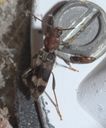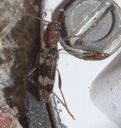Rustic Borer
Xylotrechus colonus
Classification
- Phylum: Arthropoda
- Subphylum: Hexapoda
- Class: Insecta
- Order: Coleoptera
- Suborder: Polyphaga
- Superfamily: Chrysomeloidea
- Family: Cerambycidae
- Subfamily: Cerambycinae
- Tribe: Clytini
- Genus: Xylotrechus
- Species: colonus
Pronunciation
How to pronounce Xylotrechus colonus: /zaɪloʊˈtrɛkəs kəˈloʊnəs/
These audio files are automatically generated. While they are not always 100% accurate, they are a good starting point.
Images






Summary
Xylotrechus colonus, commonly known as the rustic borer or rustic borer beetle, is a species of beetle in the family Cerambycidae, described by Johan Christian Fabricius in 1775. It is a common cerambycid in the eastern United States, feeding on several hardwood trees.
Physical Characteristics
8-15 mm in length; Broad pale markings on elytra; Narrow sinuate band at base of elytra; Wing covers are black with variable bands of grey; A sinuous yellow mark near the base; Underside is black with faint yellow banding.
Identification Tips
Look for the distinctive narrow sinuate band at the base of the elytra.
Habitat
Prefers recently killed trees and virtually all eastern hardwoods.
Distribution
Commonly found in the eastern half of the United States, from NS-FL to MN-TX.
Diet
Larvae feed almost exclusively in the bark of hardwoods; Adults feed on the nectar of goldenrod and other composite flowers.
Ecosystem Role
Plays a role in breaking down dead hardwoods through its larvae feeding.
Collecting Methods
- Attracted to lights.
Tags
- Xylotrechus colonus
- Rustic Borer
- Cerambycidae
- Beetle